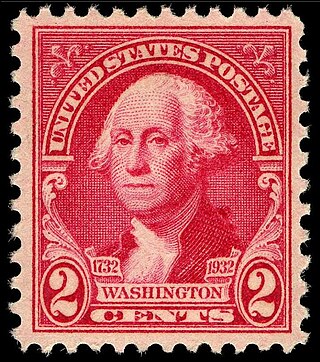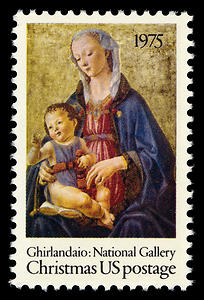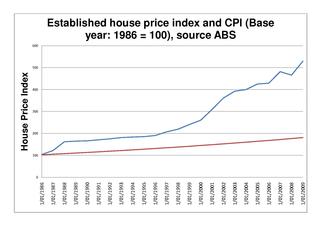This article needs additional citations for verification .(March 2021) |
This article needs additional citations for verification .(March 2021) |
For version of this table without cumulative inflation, see. [1]
The basic postage rate for a small letter has increased over the years due to inflation but influenced in recent years by a complex interplay between Australia Post's monopoly over small items, and need to provide service to all Australian addresses at the mandated basic rate. [2]
In July 2009, Australia Post requested the Australian Competition and Consumer Commission (ACCC) to approve a stamp price rise in 2010 to 60 cents but the ACCC declined the approval of the price rise, however in April 2010, Australia Post resubmitted the proposed postal stamp rise. The ACCC approved this request on 28 May 2010 and it was published in the Government Gazette on 9 June 2010. [3] [4] [5]
On 26 December 2013, due to the heavy decline in mail usage due to competition from email, etc., Australia Post requested an increase in the base rate to 70c. [6]
On 4 January 2016, due to the heavy decline in mail usage due to competition from email, etc., Australia Post requested an increase in the base rate to $1.00.
On 1 February 2020, the base rate for domestic letters became $1.10. The base rate of inflation is also shown (INF). [7]
The current base rate for domestic letters is $1.20 (since 3 January 2023).
PR INF YEAR 1d – 1.20 - 1911 3d – 2.50 - 1950 (Equals 2.50¢) 5d – 4.22 - 1959 (Equals 4.17¢) 4¢ – 4.93 - 1966 (Introduction of decimal currency) [8] 5¢ – 5.10 - 1967 6¢ – 5.59 - 1970 7¢ – 5.93 - 1971 10¢ – 7.91 - 1974 18¢ – 9.11 - 1975 20¢ – 12.52 - 1978 22¢ – 15.04 - 1980 24¢ – 16.47 - 1981 27¢ – 18.35 - 1982 30¢ – 20.18 - 1983 36¢ – 24.44 - 1986 37¢ – 26.51 - 1987 39¢ – 28.42 - 1988 41¢ – 20.55 - 1989 [9] 43¢ – 32.78 - 1990 (effective 3 September 1990) 45¢ – 34.17 - 1992 (effective 2 January 1992) [10] 45¢ – 52.42 - 2000 (effective 1 July 2000. With the introduction of the GST, the postage component was decreased to absorb the new GST cost, so for the public there was no change in stamp prices. For businesses the GST claimable component of the postage rate was 4¢, leaving a reduced cost to business users of just 41¢. 50¢ – 45.10 - 2003 (effective 13 January 2003) [11] 55¢ – 52.42 - 2008 (effective 1 September 2008) 60¢ – 54.91 - 2010 (effective 28 June 2010) 70¢ – 60.61 - 2014 (effective 31 March 2014) [12] $1.00 – 62.32 - 2016 (effective 4 January 2016) [13] $1.10 – 66.27 - 2020 (effective 1 February 2020) [7] $1.20 - ??.?? - now (effective 3 January 2023) [14]
Since about 2005, larger letters have been charged a round multiple of the base postage rate, which is helpful to customers if they do not have stocks of the more expensive stamps.
260 x 360 x 20mm – Up to 125g – $2.20 260 x 360 x 20mm – Up to 250g – $3.30 260 x 360 x 20mm – Up to 500g – $5.50 A large letter, including packaging, cannot be more than 20mm thick or larger than 260x360mm, otherwise it will be considered a parcel, which as of 2019 costs a minimum of $8.30 (up to 500 grams).
An international reply coupon (IRC) is a coupon that can be exchanged for one or more postage stamps representing the minimum postage for an unregistered priority airmail letter of up to twenty grams sent to another Universal Postal Union (UPU) member country. IRCs are accepted by all UPU member countries.

A postage stamp is a small piece of paper issued by a post office, postal administration, or other authorized vendors to customers who pay postage. Then the stamp is affixed to the face or address-side of any item of mail—an envelope or other postal cover —which they wish to send. The item is then processed by the postal system, where a postmark or cancellation mark—in modern usage indicating date and point of origin of mailing—is applied to the stamp and its left and right sides to prevent its reuse. Next the item is delivered to its addressee.

The Washington Bicentennial stamps of 1932 are postage stamps issued by the United States government in 1932 to commemorate the 200th anniversary of U.S. President George Washington's birth. Twelve stamps were issued as a collection, with each one depicting the President in a different period in his life.
Canada Post Corporation, trading as Canada Post, is a Crown corporation that functions as the primary postal operator in Canada.

The Penny Black was the world's first adhesive postage stamp used in a public postal system. It was first issued in the United Kingdom on 1 May 1840 but was not valid for use until 6 May. The stamp features a profile of Queen Victoria.

The postal and philatelic history of Canada concerns postage of the territories which have formed Canada. Before Canadian confederation, the colonies of British Columbia and Vancouver Island, Prince Edward Island, Nova Scotia, New Brunswick and Newfoundland issued stamps in their own names. The postal history falls into four major periods: French control (1604–1763), British control (1763–1841), colonial government control (1841–1867), and Canada, since 1867.

An aerogram, aerogramme, aérogramme, air letter or airletter is a thin lightweight piece of foldable and gummed paper for writing a letter for transit via airmail, in which the letter and envelope are one and the same. Most postal administrations forbid enclosures in these light letters, which are usually sent abroad at a preferential rate. Printed warnings existed to say that an enclosure would cause the mail to go at the higher letter rate.

The postage stamps and postal system of the Confederate States of America carried the mail of the Confederacy for a brief period in U.S. history. Early in 1861 when South Carolina no longer considered itself part of the Union and demanded that the U.S. Army abandon Fort Sumter, plans for a Confederate postal system were already underway. Indeed, the Confederate Post Office was established on February 21, 1861; and it was not until April 12 that the American Civil War officially began, when the Confederate Army fired upon U.S. soldiers who had refused to abandon the fort. However, the United States Post Office Department continued to handle the mail of the seceded states as usual during the first weeks of the war. It was not until June 1 that the Confederate Post Office took over collection and delivery, now faced with the task of providing postage stamps and mail services for its citizens.

This is an overview of the postage stamps and postal history of Australia.

Australia Post, formally known as the Australian Postal Corporation, is a Commonwealth government-owned corporation that provides postal services throughout Australia. Australia Post's head office is located on Bourke Street, Melbourne, above the Bourke Street Post Office.

The system for mail delivery in the United States has developed with the nation. Rates were based on the distance between sender and receiver in the early years of the nation. In the middle of the 19th century, rates stabilized to one price regardless of distance. Rates were relatively unchanged until 1968, when the price was increased every few years by a small amount. Comparing the increases with a price index, the price of a first class stamp has been steady. The seal of the Post Office Department showed a man on a running horse, even as railroads and, later, motorized trucks and airplanes moved mail. In 1971, the Post Office became the United States Postal Service, with rates set by the Postal Regulatory Commission, with some oversight by Congress. Air mail became standard in 1975. In the 21st century, prices were segmented to match the sorting machinery in use; non-standard letters required slightly higher postage.

The American Letter Mail Company was started by Lysander Spooner in 1844, competing against the legal monopoly of the United States Post Office.

In philately, the denomination is the "inscribed value of a stamp".

Non-denominated postage is a postage stamp intended to meet a certain postage rate, but printed without the denomination, the price for that rate. They may retain full validity for the intended rate, regardless of later rate changes, or they may retain validity only for the original purchase price. In many English-speaking countries, it is called non-value indicator or non-value indicated (NVI) postage. Introduced to reduce the cost of printing large issues of low-value stamps to "top-up" old issues, NVI stamps are used in many countries.
Goods and Services Tax (GST) in Singapore is a value added tax (VAT) of 9% levied on import of goods, as well as most supplies of goods and services. Exemptions are given for the sales and leases of residential properties, importation and local supply of investment precious metals and most financial services. Export of goods and international services are zero-rated. GST is also absorbed by the government for public healthcare services, such as at public hospitals and polyclinics.

The Presidential Issue, nicknamed the Prexies by collectors, is the series of definitive postage stamps issued in the United States in 1938, featuring all 29 U.S. presidents who were in office between 1789 and 1928, from George Washington to Calvin Coolidge. The presidents appear as small profile busts printed in solid-color designs through 50¢, and then as black on white images surrounded by colored lettering and ornamentation for $1, $2, and $5 values. Additional stamps in fractional-cent denominations offer busts of Benjamin Franklin and Martha Washington, as well as an engraving of the White House. With its total of 32 stamps, this was the largest definitive series yet issued by the U. S. Post Office.

In philatelic terminology a letter sheet, often written lettersheet, is a sheet of paper that can be folded, usually sealed, and mailed without the use of an envelope, or it can also be a similar item of postal stationery issued by a postal authority. Letter sheets derive from the form in which written correspondence was made up before the mid-19th century—letters were written on one or more sheets of paper that were folded and sealed in such a way that the address could be written on the outside.

The Australian property bubble is the economic theory that the Australian property market has become or is becoming significantly overpriced and due for a significant downturn. Since the early 2010s, various commentators, including one Treasury official, have claimed the Australian property market is in a significant bubble.

The Regular Issues of 1922–1931 were a series of 27 U.S. postage stamps issued for general everyday use by the U.S. Post Office. Unlike the definitives previously in use, which presented only a Washington or Franklin image, each of these definitive stamps depicted a different president or other subject, with Washington and Franklin each confined to a single denomination. The series not only restored the historical tradition of honoring multiple presidents on U.S. Postage but extended it. Offering the customary presidential portraits of the martyred Lincoln and Garfield, the war hero Grant, and the founding fathers Washington and Jefferson, the series also memorialized some of the more recently deceased presidents, beginning with Hayes, McKinley, Cleveland and Roosevelt. Later, the deaths of Harding, Wilson and Taft all prompted additions to the presidential roster of Regular Issue stamps, and Benjamin Harrison's demise (1901) was belatedly deemed recent enough to be acknowledged as well, even though it had already been recognized in the Series of 1902. The Regular Issues also included other notable Americans, such as Martha Washington and Nathan Hale—and, moreover, was the first definitive series since 1869 to offer iconic American pictorial images: these included the Statue of Liberty, the Capitol Building and others. The first time (1869) that images other than portraits of statesmen had been featured on U.S. postage, the general public disapproved, complaining that the scenes were no substitute for images of presidents and Franklin. However, with the release of these 1922 regular issues, the various scenes—which included the Statue of Liberty, the Lincoln Memorial and even an engraving of an American Buffalo—prompted no objections. To be sure, this series presented pictorial images only on the higher-value stamps; the more commonly used denominations, of 12 cents and lower, still offered the traditional portraits.

The history of Virginia through the colonial period on into contemporary times has been depicted and commemorated on postage stamps accounting for many important personalities, places and events involving the nation's history. Themes are particularly rich in early American and new nation history, historical landmarks, and Virginia-born presidents.
reflecting an increase in the standard postage stamp price from 41 cents to 45 cents between September 1990 and January 1992
The Australian Competition and Consumer Commission today announced its final decision not to object to Australia Post's request to increase the price of the basic postage stamp from 45c to 50c. The increase, which will take effect from January 2003, will see the price of the basic postage stamp rise for the first time in 10 years